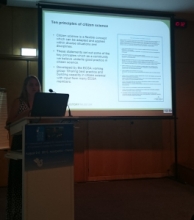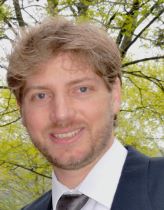Symposium: Science-Society Dialogue – from Citizen Science to Co-Design
by Muki Haklay; republished with permission from Po Ve Sham. Modified by Claudia Goebel.
The final day of the ICCB/ECCB 2015 (see my notes on citizen science sessions from Day 1, Day 2 and Day 3) included a symposium that was organised by Aletta Bonn and members of the European Citizen Science Association (ECSA) to explore the wider context of citizen science. The symposium title was Science-Society Dialogue – From Citizen Science To Co-Design. The 6 talks of the session (including mine) were:
Ten principles of citizen science: Sharing best practice amongst the citizen science community
Lucy Robinson (NHM) – the London NHM have been active in citizen science for the past 10 years, though indirectly for much longer. They see the importance of developing citizen science as a field, and especially through networks such as ECSA – a network of different people who are involved in citizen science – advancing the field and sharing knowledge. There are different definitions of citizen science, but it is important to think about best practices, and part of the work in ECSA Lucy leads the effort to share best practice. This includes the development of the 10 principles of citizen science, which can be summarised as (![]() ecsa_ten_principles_of_citizen_science.pdf):
ecsa_ten_principles_of_citizen_science.pdf):
- Involve citizens in the process in a meaningful way.
- Activities should have a genuine science outcomes.
- All involved should benefit.
- Citizen scientists may participate in multiple stages of the scientific process.
- Providing feedback to participants.
- Citizen science should be considered as a research approach and understanding. the limitations, biases and not over estimating what is possible.
- Data and metadata should be made available and results should be open access.
- Acknowledging participants in results.
- Need for evaluation for scientific output, data quality, participant experience and wider social and policy impacts.
- Need to pay attention to legal and ethical issues of copyright, IP, data sharing, confidentiality, attribution, and environmental impacts.
Celebrating 50 years of the biological records centre
Helen Roy covered the history fo the UK Biological Record Centre (BRC). The BRC coordinates 85 recording schemes and societies in the UK which are covering wide range of taxa, with publications of atlases in different topics that are covered by these programmes. The people who are involved in these schemes provide a lot of data, and to celebrate it there is a several papers on the 50 years of the BRC in the Biological Journal. Biological recording have developed with different ways – biological recording don’t have a specific scientific aims – just passion about collecting and identifying the different taxa. The national schemes are diverse – from 500 members of a bees, wasps & ants recording charity or a leafhoppers society that is more ad-hoc, to the completely ad-hoc ladybird recording survey, with 17,000 recorders. All the different schemes are lead by an individual, but involved a wide variety of people and there are now programmes that are involving many young people, which is important for the future of recording. There are mutual benefits – the recorders provide information but they get tools that help them – even stacking envelopes and sending newsletters, as well as data management, website design, editing atlases etc. The BRC is benefits from working with wide range of volunteer experts, and use the data for many purposes. The core activity is to create the National Biodiversity Network (NBN) – collect, review, share, publish and integrate the information. There are different technologies that support it from iRecord to NBN Gateway. Examples of how the Data was used include the analysis of invasion of alien species, as well as predictions of invasive species, informing UK biodiversity indicators, demonstrating impacts of climate change and modelling future distributions. The environmental challenges require a lot of data, and through this extensive community (summary of her previous talk on the history of BRC at the BES 2014). (Slides here)
Potential of digital technologies to enhance openness in learning and science
Marisa Ponti – many citizen science project still happen off line, and there are many digital technologies that can be used to share and use the data. However, it is worth thinking about the potential of educational resources that can be used in such programmes. Open education and resources – learning, teaching and research that is in the public domain under open licence for reuse and modification has a role to play. Openness and access are important to citizen scientists – it can be increased and improve in the outputs of citizen science projects. Outputs are not the final publications, but also the data, protocols, logs and systems. Open Education Resources (OER) can help in make ideas and scientific knowledge accessible, inspire people to be involved so they are not just passive participants, and can also help to meet funders’ requirements to make the research open. OER can help in reimagining what science is – can build a community outside institutional settings – such as Cornel Lab of Ornithology. It can also support self-driven and peer-based learning approaches, allowing people to run their own investigation, and OER can support experimentation with open practices. There is a specific website in the OER area of citizen science for learning and research. Resources help in creating suitable teaching sessions. There are other training material that can be reused and changed. There are, however, warning – the conditions for broad participation – OER in themselves with digital technology are not a solution unless we create the conditions for engagement of many people. There is a need to create the condition to allow participants to own the project. OER need to be in dialogue in terms of how people use them. (Slides here)
Citizen science, social learning and transforming expertise
Taru Peltola – She discuss the learning in citizen science with a paper that is currently under review (part of the ALTER-Net). In citizen science there is plenty of rhetorics – transparency, local knowledge, democracy … but social learning is usually seen with broader benefits that are related to citizen science and didn’t receive enough attention. There is a need to critically analyse the learning within citizen science, and learning is an important mechanism that require mutual learning (by participants, organisers and scientists), and learning can occur in all types of citizen science initiatives. Looking at literature on learning, there are questions on the outcomes (facts, instruments), process (individual/social/institutional), and who is involved (scientists/volunteers). It is wrong to assume that only the volunteers learn in citizen science – there are also important learning that the scientists get from the process. To gain more understanding, they looked at 14 cases across Europe – mostly monitoring species, but also cultural ecosystem services through participatory GIS or reindeer herding. The results from the cases are that the learning processes and outcomes are both intended and unintended, the learning is situated, the learning are unevenly distributed – need to pay attention who is getting the attention and how people are included, and the learning outcomes are continuous. They also found out that factual and instrumental learning outcomes are easier to assess, but it is important to pay special attention to the social and institutional process. These need to included in the design and implementation of citizen science projects. (Slides here)
Citizen science strategy 2020 for Germany
Anett Richter – The ‘citizens create knowledge – knowledge create citizens’ project is a German Citizen Science capacity building project: it includes building citizen science platform, scientific evaluation of citizen science, developing resources for teaching and developing projects and a citizen science strategy 2020 for Germany. The need for strategy is that it helps focus on a problem and thinking about how to solve it. There are many projects already happening in Germany, with museums and NGOs, as well as conservation organisations. Lots of technologies are enabling it. However, we don’t have common understanding of where we want to go? Need framework for data use, there are risks of inconsistent communication to stakeholders. The way to open the strategy is involve wide range of stakeholders in the development – public, politicians, funders, community. The wider engagement in development strategy, require time and resources and there might be lack of public interest. They run 5 dialogue forums on different issues with 400 people involved. They explore capacities in science – think of science culture for citizen science – rewards for scientists to do so. Strong data infrastructure – data quality, validation, database management and other issues. Their vision – in 2020 citizen science is integral part of German society and open in all areas of science and for all people. Also want to have reliable web-based infrastructure. They will carry out consultation online in the autumn and publishing the strategy next year. (Slides here)


















